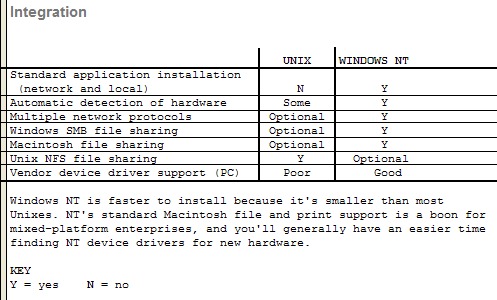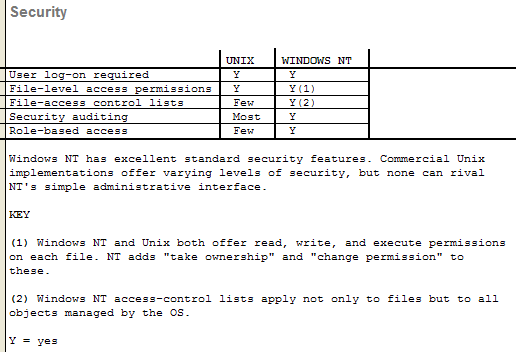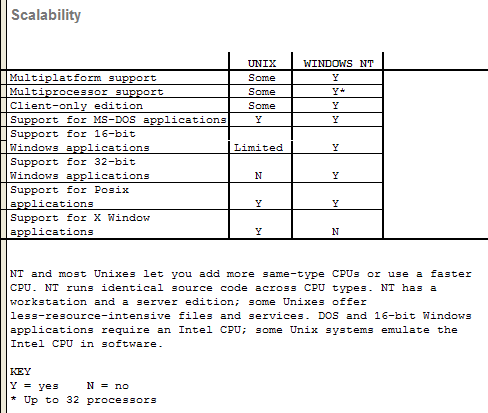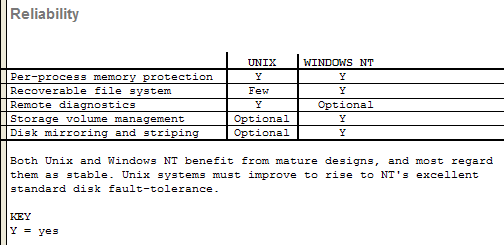| It's official: Windows NT is off probation. Nearly four
years after Microsoft's all-new, industrial-strength
operating system hit the market amid the usual hype and
hoopla, growing numbers of managers are satisfied that
it's ready for prime time. "A couple of years ago, NT was seen as not succeeding, partly because of the unrealistic projections that were made," says Hugh Ryan, director for architectures at Andersen Consulting. "But now it's being viewed as a more viable solution, especially for what I would call departmental servers. And people are evaluating its potential for enterprise-level solutions." In addition to MIS managers' growing comfort with NT, users and vendors say three other factors are working in Microsoft's favor: • NT is better positioned than Unix to take advantage of cost-effective hardware and software, particularly on the Intel x86 platform. • NT makes it easier to integrate servers and desktop PCs with Microsoft's popular Office and BackOffice suites. • Microsoft is a reassuringly safe bet for the future because its dominance of the computer industry appears to be unshakable. Is Unix Dead (Again)? One vendor that has noticed the rise of NT is Platinum Software (Irvine, CA). In 1992, around the same time that Microsoft launched NT, Platinum introduced SeQueL to Platinum, a client/server accounting package for Unix/Sybase and NT/SQL Server. At first, most of Platinum's customers chose the Unix/Sybase version for their Sun Microsystems, Hewlett-Packard, and IBM servers. "Then we started to see a shift," says Don Howren, Platinum Software's vice president of marketing. "Customers started making commitments to Windows NT and SQL Server, and now they are looking for production-level applications." "The Alpha processors and faster Pentium processors are making NT a high-volume transaction-processing environment," says Mike Pennell, Platinum's director of product strategy. "If you look back a year or two ago, it really wasn't. With the introduction of these new servers, you're seeing a lot more competition with the Unix servers." Intel-based servers that deliver more bang for the buck are driving the growth of Windows NT, according to vendors and users. Although NT runs on three different RISC architectures — the Mips Rx000, the Digital Alpha, and the IBM/Motorola PowerPC — the version that runs on x86-based systems is the most popular. Lately, Intel has greatly accelerated x86 development and is shipping faster versions of the Pentium and Pentium Pro CPUs that run neck-and-neck with the speediest RISC chips. When combined with Intel's huge manufacturing capacity and the well-known economies of the PC system architecture, the result is a price/performance value that's hard to beat. And for those who need maximum performance, NT on RISC is an option. NT's ascendancy does not mean Unix is on the rocks, however. Other sources point out that there is still a performance gap between the midrange and the high end. Architectural limitations hobble low-priced x86-based servers when they try to tackle the really big jobs. Even the best of them have trouble keeping up with the fastest Unix boxes, especially when managing large databases. When Unix teams up with major-league database software (from Oracle, Sybase, or Informix), Windows NT and SQL Server face some formidable competition. IS managers are expanding their use of both platforms. They've settled on the NT/low-end symmetric multiprocessor (SMP) server (four processors or less) as the trick setup for small to medium installations. And they continue to deploy Unix servers where bigger is better. "Microsoft has oversold the scalability of NT," says Michael Goulde, a consultant with the Patricia Seybold Group (Boston, MA). "NT is very cost-effective as far as it goes. But, in part because of the hardware that's available for running NT, it lacks the scalability of Unix platforms. You can't take it as far." Beefed-Up NT Boxes A few vendors, like Sequent Computer (Beaverton, OR), do make SMP systems for NT that have as many as 28 CPUs. Still, most Windows NT servers are less sophisticated machines with one to four CPUs — they're basically reengineered desktop PCs. Disk I/O, video, and network cards probably share the same PCI bus, and the CPUs typically have 256 KB to 1 MB of secondary cache RAM. Compare that to Sequent's WinServer 70, which has a double-sided backplane with a proprietary high-speed bus, an independent VME bus for network adapters, as many as 32 fast-and-wide SCSI channels for disk I/O, and 2 MB of secondary cache per CPU. "If you compare some of the cheaper four-processor Intel-based machines to, say, the Alpha 2100, the difference isn't just CPU speed. It's the complete system architecture," notes Goulde. With its heavy-duty hardware, "the 2100 is designed more like a minicomputer." Still, some users are testing the limits of NT. At Oregon State University (Corvallis), the College of Oceanic and Atmospheric Sciences handles data collected by field researchers and weather satellites. The platform? NT and SQL Server on a pair of dual-Pentium Hewlett-Packard servers to manage about 100 GB of data. The college is working on a NASA project called the Earth Observing System, which will launch several more satellites into orbit over the next few years. When that data starts pouring in, the database will expand into the terabyte range. Mark Abbott, a professor who helps run the program, says his goal is to produce videos and animations that will let scientists more easily visualize this vast storehouse of raw data. That's why he chose NT and SQL Server to replace an Ingres database on HP-UX (Hewlett-Packard Unix). "We wanted stronger links between data analysis and data management," says Abbott. "That's something NT is very good at. The technical strengths and directions of NT were very compelling." The lower hardware and software costs of NT-based systems were also compelling. Some of the data-manipulation programs the college is using cost only $60. "We wanted to get on the price/performance curve of the PC market," explains Abbott. "Ninety-five percent of our money comes from competitive federal grants, so we're more like a business than a university." As his databases grow, however, he's aware that NT may not keep up. "Scaling and robustness are still major concerns, which is why we still have some Unix boxes." Microsoft continues to work with Sequent and other SMP vendors to improve NT's scalability, but Unix will retain this advantage for some time to come. "NT scales pretty well with Unix up to six or eight processors, but not beyond that," acknowledges Bob Robinson, Sequent's product marketing manager. Scalability problems arise from both the hardware limitations of PC-based servers and inherent limitations of NT itself — limitations that Microsoft naturally disputes. Windows, Meet Windows Of course, NT isn't the only server OS that can take advantage of cost-effective x86-based hardware. So can Novell NetWare, IBM OS/2, and SCO Unix. SCO Unix itself is running on about two million x86-based servers — more than any other version of Unix, according to SCO. Obviously, there must be additional reasons why increasing numbers of MIS managers are choosing NT. One factor, they say, is that it's easier to integrate Windows NT with their existing hardware and software. Installations that already have Windows PCs on their desktops naturally lean toward NT when they have to choose among server options. They would rather deal with a single OS vendor, and NT has an instantly familiar look and feel. On top of that, Microsoft Office commands an overwhelming 85 to 90 percent share of the market for application suites, according to Dataquest and other market researchers. And BackOffice, particularly SQL Server with its low price, provides a powerful incentive to try NT, especially if you're charged with rolling out a departmental client/server database system on a limited budget. "We're seeing heavy NT adoption in companies with widespread Windows on the desktop," says Ryan of Andersen Consulting. "There is a sense that Unix is a more technically demanding environment, both in terms of productivity and connectivity issues." These were some of the factors that convinced Penn State University (State College, PA) to switch from Banyan Vines to NT for about 1000 networked computers in classrooms and student labs. Most of Penn State's client machines are running Windows for Workgroups on 75- and 100-MHz Pentium PCs; there are also some Power Macintosh 7100s. To handle these desktops (and upwards of 100,000 users, counting full- and part-time students), the network has about 25 servers, mostly 486 and Pentium systems. Penn State evaluated NT for years before making a commitment. Finally, in March '95, the conversion began. It took about six months, and so far the school likes the stability, security, and economy of NT. "We wanted something robust that we could expand," says Al Williams, manager of distributed system services. "TCP/IP support, Ethernet routing support, and Mac OS support were all part of the basic package. Some of these services would have been extra on Banyan Vines, and they would have been costly." The Macintosh creates a well-known problem for network operating systems like Vines and NetWare: It supports long filenames. In order to make Vines or NetWare support long filenames, you have to run a separate namespace — one that isn't always compatible with sharing volumes between PCs and Macs. NT provides long-filename support for Macs natively. NT also supports AppleTalk networking protocols. Corporate and commercial software developers say NT and OLE offer more interesting possibilities for integrating their applications with Microsoft Office and BackOffice. They can build custom solutions using OLE objects and an expanding array of rapid application development (RAD) tools, such as Microsoft's Visual Basic, PowerSoft's PowerBuilder, and Borland's Delphi. Unix does not support such a wide choice of popular RAD tools. "OLE becomes the infrastructure with which you can customize and deploy our applications at customer sites," Pennell at Platinum Software says. "We can not only integrate with the standard suite of Microsoft front-office products such as Word and Excel, but also with other financial-specific products, such as a tax-processing or an add-on order-entry system." Of course, similar technology is not exactly unknown on Unix. A good example is Sun's Neo (Network Objects), a distributed object environment. Neo allows users to integrate Common Object Request Broker Architecture (CORBA) objects and even OLE objects with applications and databases across a network. Neo works with Java applets, too. Besides, although it seems as if Windows rules the world, not everyone is primarily concerned about integrating desktop PCs into their networks. "We've had customers who looked at NT but chose Unix because they don't have Windows clients," says Jeff Ait, vice president of SCO's Internet strategy. "There are a lot of different clients out there — automatic teller machines, cash registers, character-based terminals, telephony devices." Still, there's no question that MIS managers want easy, seamless integration with the Windows PCs that dominate corporate desktops. Although some managers express reservations about Microsoft's industry dominance, they also crave the stability of industry standards. NT dovetails with the desktop hardware and software on which the vast majority of companies have decided to standardize. Struggle for the Internet Dislodging any OS from a site where it's already entrenched is difficult, even for a force as powerful as Microsoft. MIS managers tend to be fairly conservative folks who stick with things that work. That's why Microsoft and the numerous Unix vendors are hotly pursuing new installations where legacy issues — including systems, software, user training, and administrative support staff — are mostly nonexistent and the terrain is wide open. Examples of these potentially lucrative new markets are interactive TV networks, the World Wide Web, and the high-speed networks required for the $500 network computers envisioned by such companies as Oracle, Sun Microsystems, and IBM. Interactive TVs and $500 computers are still highly speculative, but the Web is here now and growing fast. Market research indicates Unix systems have jumped to an early lead on the Web and that Sun is doing particularly well. Some analysts think Sun is basking in the glow of Java, its multiplatform language for Web applets. "Everyone is very excited about Java," says David Flaxman, partner for advanced technology at KPMG-Peat Marwick (Radnor, PA), a systems integrator and consulting company. "People perceive that Sun is setting the standards for the Internet, so they want to buy a Sun for their Web server. That's not necessarily a rational connection, but it's there." By contrast, Microsoft's strategy until late 1995 seemed proprietary. Microsoft originally promoted the Microsoft Network (MSN) as a self-contained alternative to the Internet and released a development tool for on-line publishing that worked only with MSN. Last December, at a press event in Seattle, Microsoft altered its course and embraced the Internet. Among other things, Microsoft announced it would move parts of MSN onto the public Web, turn its MSN publishing tool into a standard Web tool (Internet Studio), integrate a Java run-time engine into its free Web browser (Internet Explorer), and bundle its Internet server software with future versions of NT Server. Microsoft's turnabout is welcome news, but it came too late for early Web adopters. Two years ago, when entrepreneur Larry White was launching a new Web-based magazine for photography enthusiasts called HyperZine, he and his partner chose a Sun SparcStation 20 for their server. HyperZine (www.hyperzine.com) now runs on Solaris 2.4, Netscape's Netsite, and an Illustra database. White uses Perl scripts and Microsoft Access to link Illustra tables into Hypertext Markup Language (HTML) pages, so his on-line magazine generates many of its Web pages on the fly in response to user input. The same SparcStation server hosts about a dozen other Web sites for White's clients. Each Web site has its own Domain Naming System (DNS) address, so they appear as independent sites to Web surfers. "That's why we felt we needed a workhorse like the Sun," White explains. "At the time, we didn't feel that confident with NT. The same with the Macintosh server solutions." If he were starting today, though, White says he'd consider NT. "I'll do anything it takes to get the job done. I'll use a Sun, a PC, a Mac, an Amiga. Whatever is best for that solution at that moment." SCO foresees even greater potential for Unix on intranets — private corporate networks assembled with the same server software, client browsers, and publishing tools developed for the public Web. An intranet could be as small as an internal LAN, or it could use the public Internet as a virtual WAN. "The intranet opportunity for Web servers is probably 10 times as large as the Internet opportunity," says SCO's Ait. For example, SCO currently has only two servers on its public Web site, but about 200 servers on its private intranet. When ordinary users log onto SCO's home page (http://www.sco.com), they can't get past the two public servers. Employees, however, can gain secure access to the intranet and use it like a private Web. SCO's employees are starting to format many of their documents — such as product data sheets, press releases, white papers, and brochures — in HTML, the lingua franca of the Web. That way, coworkers in remote offices can retrieve, view, and print the documents with any Web browser. High-quality color printers generate copies of data sheets on demand, reducing the amount of out-of-date sheets headed for the trash. Plus, documents bound for public consumption are already in the proper format for the public Web servers. None of this has escaped the attention of Microsoft. As part of its born-again Internet strategy, Microsoft is adding Internet features to all its relevant products. By the end of this year, Microsoft promises, Office applications will let you save, open, and print HTML documents. (Word already has an add-in called Internet Assistant that provides these features.) Built-in browsers will bring the informational resources of the Web to your desktop. New OLE controls for Visual Basic will let programmers build Web connectivity into their programs. And VB Script will provide an alternative to JavaScript for applets. The Internet may have been born and nurtured on Unix , but Microsoft wants it to flower on Windows. It's a Standoff Clearly it makes little sense to declare a winner in the ongoing and evolving NT vs. Unix battle. We can draw some conclusions, however. • Windows NT is definitely gaining ground in corporate installations, but because the global computer market continues to expand at a prodigious rate, NT is not killing off Unix. On the contrary, Unix is likely to thrive into the next century. • Unix is still the best solution for large databases and other enterprise-scale jobs. That won't change until Microsoft radically improves the scalability of NT and SQL Server on SMP machines with six or more processors. Also, NT has no time server, which may rule it out for large on-line transaction processing (OLTP) systems. • NT is winning more mind share among users. It's new, it's hot, it's from Microsoft, and it has "Windows" in its name. Unix suffers from discrimination against old age and from disunity among vendors. People who cut their teeth on Windows are moving into authority and will increasingly look toward Microsoft for solutions. • Microsoft's slow embrace of the Internet has worked to the advantage of Unix. But by bundling Internet software with NT Server and making its leading applications Internet-aware, Microsoft can establish NT as the no-brainer choice for companies that are setting up new Web sites and intranets. • Microsoft has a strong tools strategy with Visual Basic, VB for Applications, VB Script, Visual C++, and OLE. However, as users become more Internet-savvy and multiplatform-minded, that strategy must become less proprietary and Windows-based. Sun has blazed a path with Java that Microsoft needs to follow. In the end, there is no one-size-fits-all answer to which OS is better. Experts who want to craft the best possible solution for a given business problem must be knowledgeable enough and open-minded enough to adopt either OS — or both. Sidebars:

*Windows NT and Unix both offer read, write, and execute permissions on each file. NT adds "take ownership" and "change permission" to these. †Windows NT access-control lists apply not only to files but to all objects managed by the OS. 

*Up to 32 processors 

Tom R. Halfhill is a BYTE senior editor based in San Mateo, California. You can reach him at thalfhill@bix.com. Inbox / July 1996Unix vs. NT"Unix vs. Windows NT" (May cover story) was very well done and informative. However, you overlooked Linux, which definitely has potential in many organizations and is a more cost-effective OS for the x86 platform than Windows NT.John Iliff Pinellas Park Public Library Pinellas Park, FL http://pppl.tblc.lib.fl.us It was not possible to consider all the flavors of Unix. I tried to keep my discussion generic, focusing on Sun in a few cases because of its status as a primary flag-bearer. Linux could be a good solution for some installations, but other businesses might be reluctant to adopt a Unix that is perhaps not as well supported by a single vendor as other variants, such as Solaris, AIX, or HP-UX. Some MIS directors want that "big business" relationship with their vendors. It costs more, but it makes them feel more comfortable. — Tom R. Halfhill, senior editor In the article on Unix vs. NT, you say, "Architectural limitations hobble low-priced x86-based servers when they try to tackle the really big jobs." Most of the rest of the article suggests that the reason x86 boxes running NT cannot keep up with Unix boxes is they do not have enough processor power, but that this can be fixed by improving NT's symmetric multiprocessing (SMP) scalability. I disagree. Benchmarks we performed in 1995 showed that NT experiences an I/O bottleneck long before it runs out of processor throughput. Jonathan Handler 71702.1620@compuserve.com I was talking about much more than CPU power — indeed, the Pentium Pro holds its own with the fastest RISC chips in terms of integer performance. The main limitations are system architectures and the inability of NT to scale linearly beyond six or eight processors in an SMP system. Unix is more scalable in this regard, and Unix servers tend to be built on superior system architectures that deliver higher overall performance. Of course, they usually cost a lot more, too. In this issue of BYTE, we analyze two new server architectures that attempt to address this problem (see "The Network Inside the Server," page 151). One of them, Sequent's NUMA-Q, is based on the Pentium Pro and supports both a Unix variant (DYNIX/ptx) and NT. — Tom R. Halfhill Inbox / August 1996Unix vs. NT — and OS/2I was displeased at not seeing OS/2 included in your article "Unix vs. NT" (May). I believe there are more LAN Servers out there than NT servers — your own pie charts show what a small fraction of the market NT currently has, despite all the predictions for its glorious future. However, OS/2 didn't even rate a text box. Geoffrey Snyder gsnyder@gsnyder.seanet.com This was strictly a story about Unix and Windows NT. In addition to not bringing OS/2 into the discussion, we didn't write about NetWare, the Mac OS, the many different versions of Unix, or any other OSes. We cover all those OSes regularly in BYTE; in fact, we're the only computer magazine to do so. In this case, we decided to focus on Windows NT — because of its status as a newcomer — and compare it to Unix as a representative of the old guard. No slight to other OSes was intended. — Tom R. Halfhill, senior editor Copyright 1994-1998 BYTE |